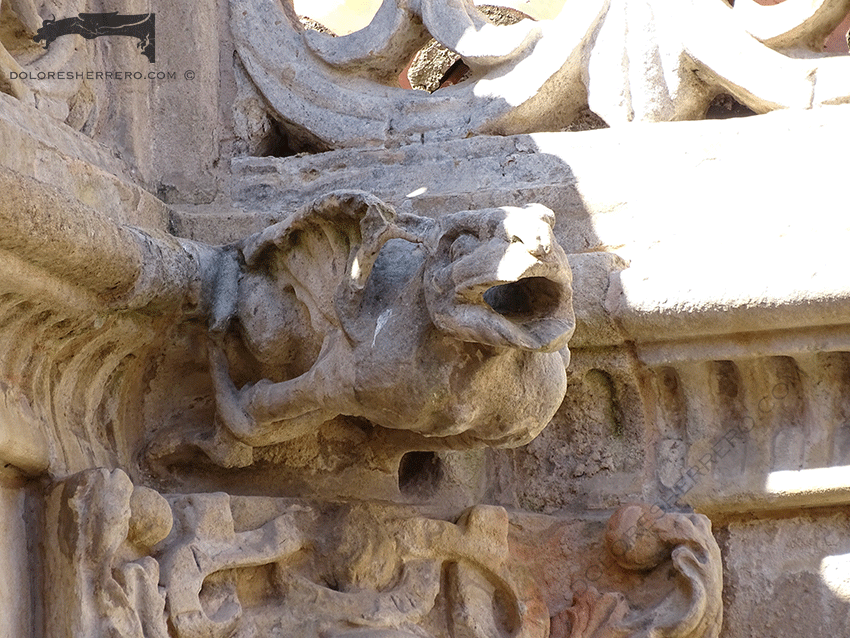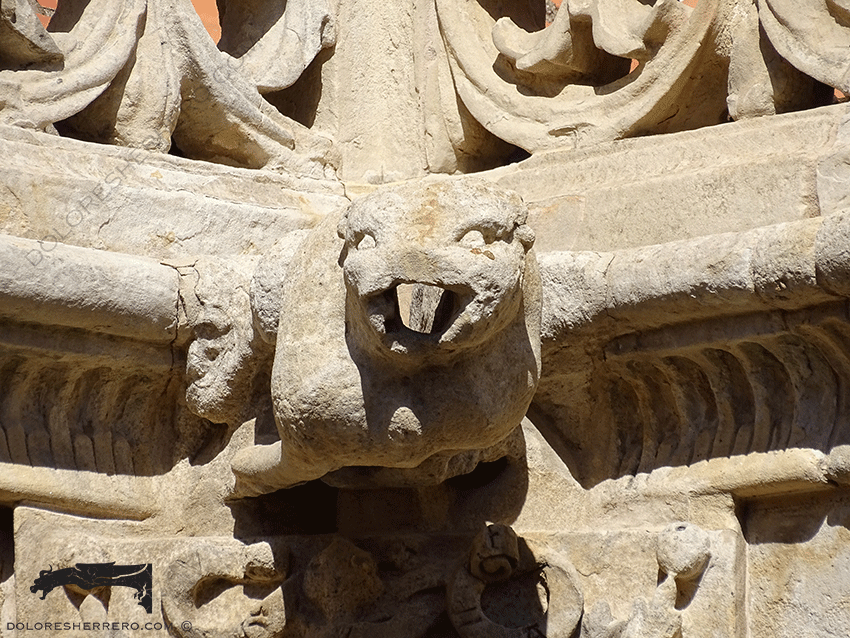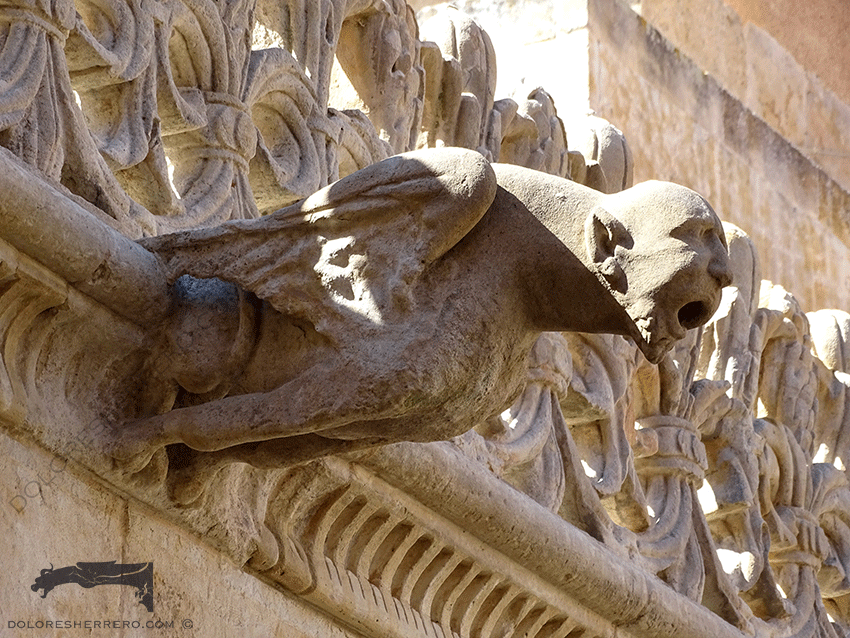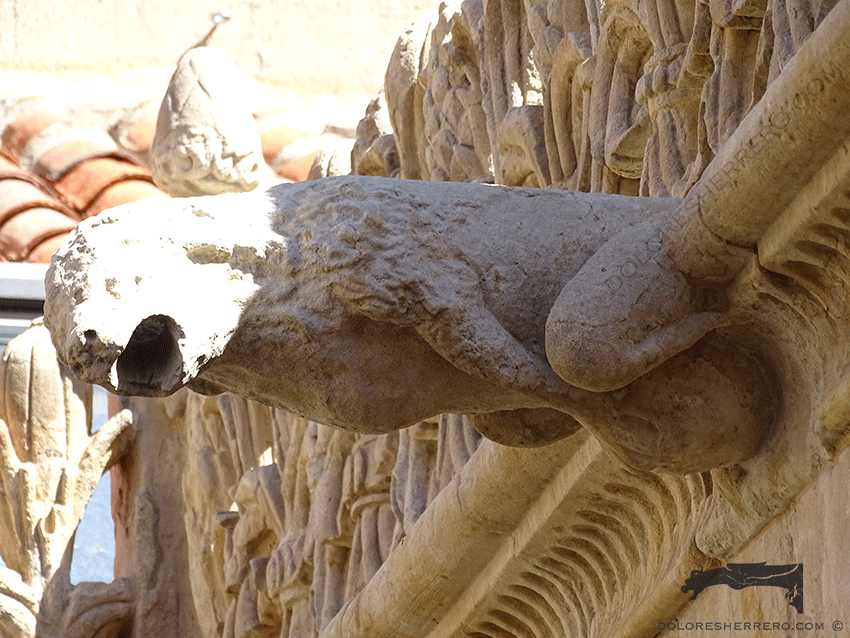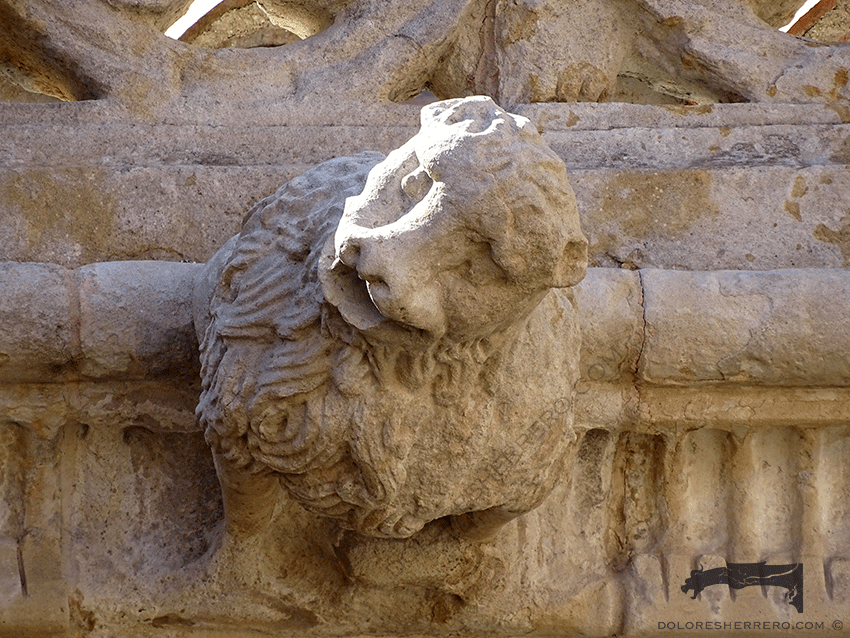Today’s entry is dedicated to the amazing gargoyles of one of the most beautiful buildings in Salamanca (Spain). We are referring to the magnificent Casa de las Conchas (House of Shells).
This building dates from the late 15th and early 16th centuries, and was commissioned by Rodrigo Maldonado de Talavera, knight of the Order of Santiago. His son, Rodrigo Arias de Maldonado, continued the work and, at the beginning of the 18th century, the building was renovated and expanded.
The house combines different styles: Gothic, Renaissance, Plateresque and Mudéjar, and is a symbol of the political power of the nobility of the time.

The Gargoyles of the Casa de las Conchas: Stone Symbols and Guardians of the Past
The magnificent inner courtyard is divided into two sections: the lower one, with mixtilinear arches on pillars; and the upper one, with segmental arches on Carrara marble columns, with a beautifully decorated balustrade. It is here that the amazing gargoyles that embellish this courtyard can be found.
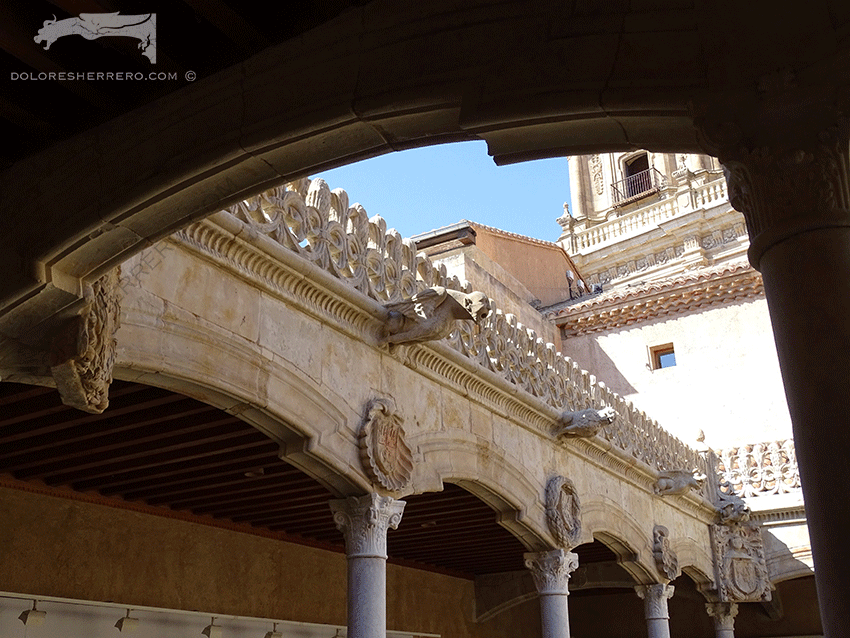
The first gargoyle shown here is a demon with the body of a winged quadruped, with a pronounced windpipe and bat-like wings, these being typical features of the demonic type.
The next one, although it looks like a dog, has a long goatee that gives it the category of a demon.
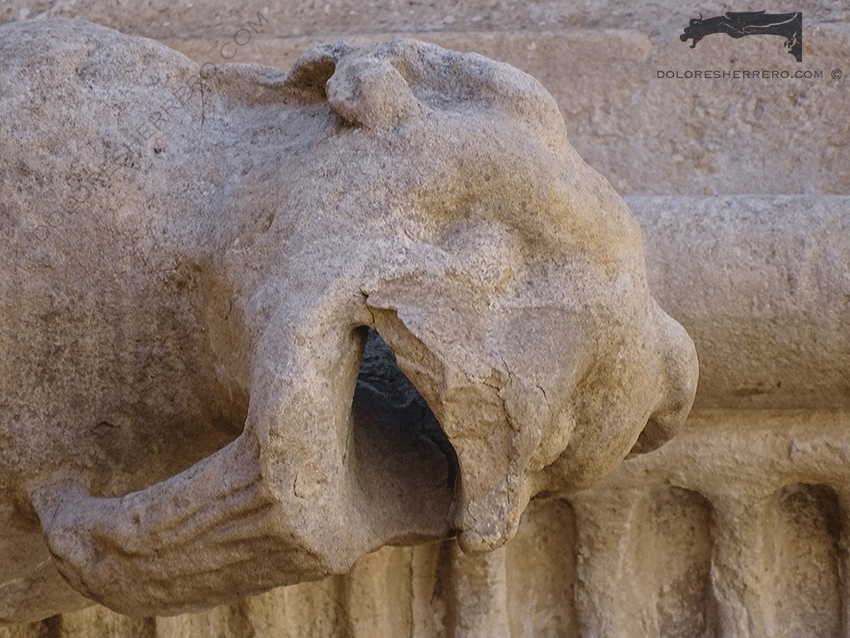
The next gargoyle we highlight here is a very picturesque one. It is a winged quadruped with patterned wings and a fantastic-looking head. Unique and completely different from the rest of the gargoyles in the courtyard, it has round, hollow eyes, protruding eyebrows and a large mouth that seems to be smiling, all of which make it a grotesque, highly imaginative figure.

We now turn to the peculiar figures of dogs, one of the most frequently represented animals among gargoyles. As we have already seen in the entry dedicated to this beloved animal, let us remember that the dog is an example of loyalty and vigilance, a protector of houses and their inhabitants. We have references from Antiquity, such as Cerberus, who guarded Hades. In relation to Christian symbolism, he appears as a shepherd dog guarding his flock and protecting it from the wolf, just as the priest guards and protects his parishioners from the devil. It also has a negative symbolism. In his Ecclesiastical History, Eusebius of Caesarea (3rd-4th century) compares the dog to the devil on the basis of Cerberus. Although the Middle Ages revived the symbolism of the dog as man’s faithful friend, there are medieval texts in which it appears as a symbol of certain vices and sins, such as envy. The Libro de los Enxiemplos (14th century) shows it as the personification of hypocrites, flatterers, and ingrates.
These are highly unique and expressive gargoyles with a flattened face and squat body, and a magnificent carving. One of them has a small figure or creature underneath, made unrecognisable by its deteriorated state.
There is also an anthropomorph, a hybrid with the head of a man and the body of a quadruped. It has a long straight mane and a long goatee, as well an expression of what may be grief or distress. It wears a skull-cap on its head. Anthropomorphs are semi-humans, animals that possess human physical traits, or that bear something that identifies them with men and women, such as clothing, etc. The anthropomorph is a fascinating creature that has belonged to the world of monsters and mythological creatures since Ancient times.
Another anthropomorph is a winged quadruped with a human head. It is a highly expressive gargoyle, as can be seen in the frown and the wrinkles between the eyebrows, with an expression of suffering or pain. The goatee and the slightly pointed ears also give it a demonic appearance.

There is a gargoyle resembling a griffin. Although its mouth or beak has deteriorated, we can see the body and tail of a lion, and the wings and plume of a bird. The griffin is a mythological animal, half eagle (upper part) and half lion (lower part). Its representation dates back to ancient times (Persia, Babylon, ancient India). In Greece and Rome, they were considered guardians of the tombs. The griffin is a symbol of wisdom and also a guardian of treasures, especially emeralds. It possesses both the attributes of the lion and those of the eagle, animals of important Christian symbolism, making it one of the best emblems of the dual nature of Jesus Christ: the eagle’s bust represents Christ’s divinity, and the lion’s body represents his humanity. As for its negative powers, the griffin often symbolises the devil with its predatory beak and claws.
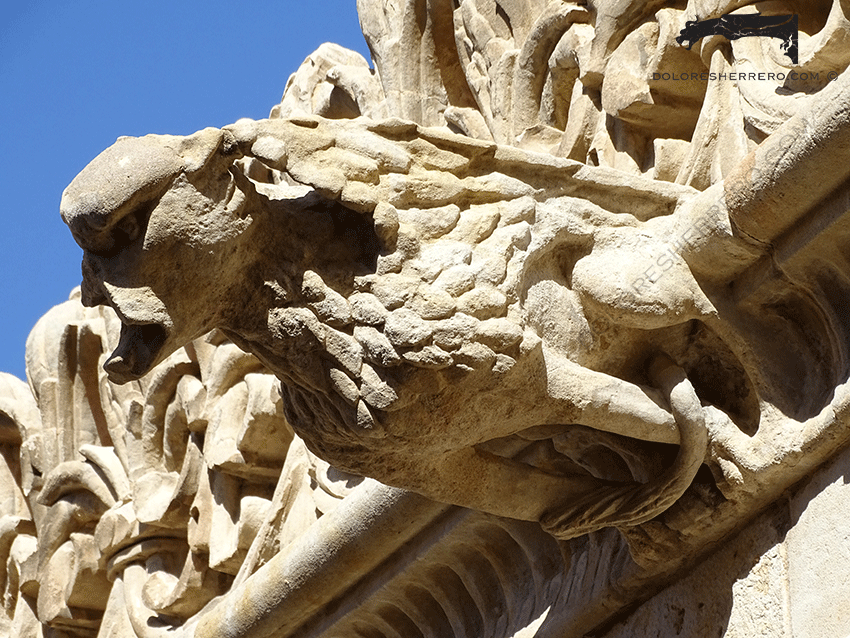
Another animal represented is the lion. One of them has a long mane and rests one paw on an undefined lump. As we know, the lion is probably the animal most often depicted on gargoyles. It is the king of land animals, which was adopted by Christian iconography, the Lion of the Tribe of Judah, a symbol of Christ. It is also an emblem of vigilance, which is why it appears on tombs, buildings and doors as a door knocker. As for its negative meaning, although it is not common, it can be considered a symbol of pride or of the Antichrist, or as a demon that takes possession of souls.
The other lion has a long mane and a tilted head. The twisted or tilted heads and bodies add dynamism and expressiveness to the gargoyles.
Although the iconography is varied, the figures of the lion and the dog predominate. In addition to their consideration as guardian and protective animals –emblems of power and loyalty, qualities linked to nobility– the lion is a part of the Maldonado family coat of arms that can be seen throughout the building, a sign of the importance of this nobility and the power it embodied.
It is in the Casa de las Conchas, and in the city of Salamanca in general, where we can appreciate the coexistence of styles and the transition point, through art, from the Middle Ages to the Modern Age. As you have seen, its amazing gargoyles boast a great formal and typological richness, as well as expressiveness and plasticity. A true jewel of Castile and León’s heritage.
Bibliography consulted
CHARBONNEAU-LASSAY, L., El bestiario de Cristo. El simbolismo animal en la Antigüedad y la Edad Media, vol. I y II, Palma de Mallorca, José J. de Olañeta, Editor, 1997.
DELACAMPAGNE, A. y C., Animales extraños y fabulosos. Un bestiario fantástico en el arte, Madrid, Editorial Casariego, 2005.
GRIVOT, D., Le diable dans la cathedrale, Paris, Editions Morel, 1960.
MATEO GÓMEZ, I., Temas profanos en la escultura gótica española. Las sillerías de coro, Madrid, CSIC. Instituto Diego Velázquez, 1979.
PINEDO, R. de, El simbolismo en la escultura medieval española, Madrid, Espasa-Calpe, S. A., 1930.

Doctor of Art History and researcher specializing in the study of gargoyles.
I am Dolores Herrero Ferrio, and my thesis, “An Approach to the Study of Gargoyles of Gothic Cathedrals in Castilla and León”, is dedicated to the study of these fascinating figures.
If you like gargoyles and art history, you will also enjoy my book, “The Gargoyle and Its Iconography,” a book I have written with great care for those interested in the world of gargoyles.
I have created my own Encyclopedia of Gargoyles, a Gargopedia to share with you, where you will discover all the secrets and wonders of these enigmatic sculptures.
I hope you enjoy this Gargopedia as much as I have enjoyed creating it, and remember that each gargoyle has a story to tell, and here you will discover them all.
